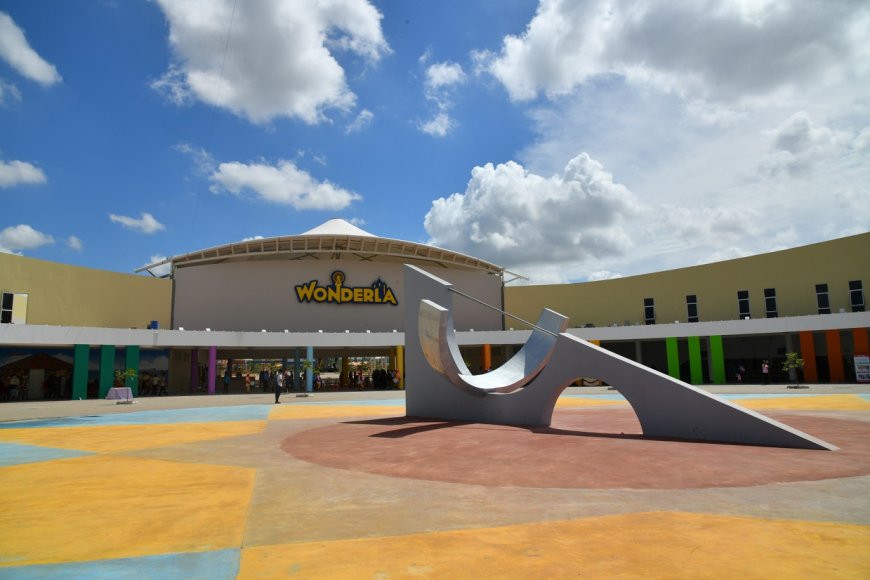The 51-acre Wonderla Bhubaneshwar campus journey is navigated by a series of experiential nodes.

Anup Naik,
What inspired the design of Wonderla Bhubaneswar amusement park, and how was it integrated into the architecture?
Our main source of inspiration is from the holy land of Odisha itself. This region is believed to be divided into four Kshetras namely Sankha, Chakra, Gada and Padma. Bhubaneswar falls in the Chakra Kshetra, while the coastal city of Puri lies in the Sankha Kshetra. The chakra symbol has had multiple interpretations in the culture of Odisha; the chariot wheel of the Konark Sun Temple being one such example. The cross-sectional spiral of a Sankha or Conch, forms the Fibonacci series or the golden ratio which has deep connections to both ancient and modern architecture and planning principles. This understanding gave birth to a master plan which was a dispositional overlap of the chakra and Sankha.
How did you manage to complete the project within 12 months, and what were the main challenges?
The technical team of Wonderla comes with an immense bank of knowledge from executing 3 successful parks. Their contribution in quick problem resolution and on-site execution is commendable as it has fast-tracked the completion of the project. The entire design and execution teams have been working as one unit, engaging in continuous discussions to brainstorm fast and efficient design solutions for a quicker project realisation. The project team of Wonderla has been very meticulous in planning for the same.
Another advantage for this project was the alignment of the design visions of the architect and client since day 0. Usually, projects go back and forth to arrive at a large vision and master plan, whereas in our case we were very focused on the same since the beginning. The ideas and master plan discussed on the very first day has been carried forward, bettered, and executed on site. This is a great win for both the client and the designer.
What unique challenges did you face in designing structures that balance functionality and entertainment value?
To tie our whole project together we had an overarching narrative which set the tone for the architecture and landscape of the design.
The two towers for flume and tube rides for example, were envisioned to become designed architectural elements even though they had a bare functional requirement. Similarly, the Wonder Splash mound was also weaved into the narrative as an inside-outside experience that could be navigated either by foot or on the car ride.

How did you prioritize safety while maintaining an immersive environment for visitors?
Our project site falls under the cyclone zone of 50 m/s, being a very high damage risk zone. The marquee Sky Wheel tower therefore had to be removed from the project due to a height restriction of 15 m. The structural elements follow the IS 875 (3):2015 for cyclone/wind/storm protection, and the IS: 1893 (Part 1)-2016 for earthquake resistance, with a factor of safety of 1.20. The fire safety for the campus adheres to the National Building Code; the PHE systems have been designed based on the Bureau of Indian Standard Codes; the electrical system designs are compliant of the BIS and British Standard Codes.
The aim of the master plan was also to ensure that all rides are clustered appropriately based on the type, size and intended user group. For instance, all the kids’ rides were placed within the first spiral loop, whereas rides like the spinning coaster were placed along the outermost spiral loop as they are heavy duty and heavy footfall in nature. Though placed apart from each other strategically, the experiential spiral pathway makes them easily accessible from any point within the campus.
What sustainable design principles or technologies did you incorporate into the park's architecture?
All the architectural materials used in the design has been carefully chosen to be sensitive to the local context and flavour of the region. The campus has an open green space of 67,618 sqm, with a landscape palette that includes only indigenous plant species, with 2565 trees that add to the richness of the local flora of the region.
An area of 3,000 sqm has been allocated for solar park in the parking area of the campus, with a 30% provision of EV parking also. A water harvesting pond of 1.25 cr litres capacity has been strategically located to ensure efficient water use and management on site. The total water demand of the project is 530 cum with a daily water change of 120 cum. A 670-cum Water Treatment Plant and 60 kld Sewage Treatment Plant make Wonderla Bhubaneswar a hundred percent water efficient campus, with the entire water consumed being treated and reused within.
What standout features or architectural marvels make Wonderla Bhubaneswar unique and memorable?
The 51-acre Wonderla Bhubaneshwar campus journey is navigated by a series of experiential nodes, each taking cue from a certain historic or cultural nuance from the region. The ‘Arrival Plaza’ that marks the entry to the campus has its radiating spokes developed in the concept of the Chakra. The tree lined boulevard leads one to the welcoming plaza or the ‘Sun Dial Plaza’, resembling a traditional Sundial, which is a celebration of Odisha and the Sun. The Entrance Block responds to and receives the Sun Dial Plaza. This portal-like building forms a threshold between the waiting zone and the park, thus creating a sense of anticipation and wonderment for ‘the other world’ inside. As one moves inside, the clock tower leads one to the ‘Central Plaza’. These two plazas on either side of the portal marks a dialogue between the past and the present; the entire campus unveils itself at this point.
The design of Wavepool is an ode to the maritime history of Odisha. The iconic ship on the shore is a cultural reference to ‘Boita’, paying homage to the brave mariners to have sailed the seas. The visual axis through the Sun Dial Plaza and the Central Plaza terminates at the Wondersplash, which is perched upon an artificial mound. The dome-shaped roof of the ride has its reference to a contextual architectural style, with punctures in it that lead one into a themed experiential theatre or ‘illuminarium’ inside. The journey through the campus thus becomes a celebration of the sun, land, and seasons within.







